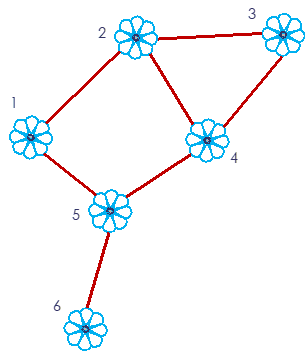Secure mobile ad-hoc routing

MaritimeManet is a mobile, ad-hoc, long-range, broadband network designed for communication between ships at sea. For wireless communication, a MaritimeManet node uses multiple directional antennas arranged in a sunflower pattern, and it automatically discovers other nodes and sets up the strongest possible wireless point-to-point connection between nodes within radio reach (see figure).
Each node in MaritimeManet must know to which next-hop node it must send data packets towards their final destination. This knowledge is provided by a routing protocol. For wireless networks with changing topology, such protocols exist for decades but are still in development. In MaritimeManet, routing can occur at layer 2, e.g., ‘Better Approach To Mobile Ad-hoc Networks’ (BATMAN), or at layer 3, such as ‘Open Link State Routing’ (OLSR) or BatMan eXtended (BMX).
A routing protocol must not only correctly perform its primary routing function, but it must also be robust for (un)intentional interferers with the correct operation. A top-down approach is to derive security requirements from analysis of attack paths on the system within its operational environment and the vulnerabilities of the system. In a bottom-up approach existing routing protocols are compared to those security requirements. This assignment uses both: the top-down approach to define a set of security requirements for routing protocols, and the bottom-up approach to select the best matching available solution that can be implemented and tested.
Work Activities:
In this assignment the student needs to address analysis of security aspects in MANET routing. Both the control plane aspects, i.e., the exchange of routing protocol messages, and the data plane aspects, i.e., the actual forwarding of user data packets using the routing tables, must be covered.
- Security analysis – An analysis is first made of the attack paths an adversary may take, and their viability in the considered operational environment, in particular the maritime environment. For each attack path, and how they may be exploited, the vulnerable MANET functions are mentioned. An assessment is made of the severity c.q. impact of exploiting each vulnerability, i.e., a risk assessment. A ranking of risks can now be made.
- Security requirements – Based on the security analysis, a set of requirements must be drafted that guide the design of security measures against these threats. It is expected that these requirements cover both control plane aspects and data plane aspects.
- MANET routing – An overview of existing MANET routing protocols and their security capabilities must be made. In this overview a comparison is made with the drafted security requirements. Based on this comparison a choice is made for a MANET routing algorithm.
- Implementation and testing – The selected routing protocol is implemented on an available testbed, and the MANET is tested for robustness against the identified threats.
Contact:
Jan Laarhuis – j.h.laarhuis@utwente.nl
